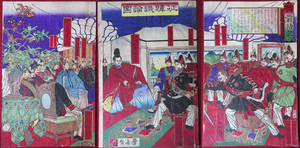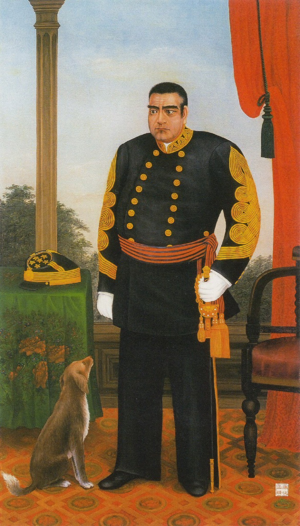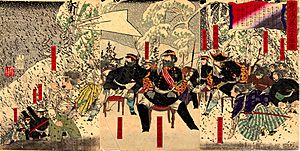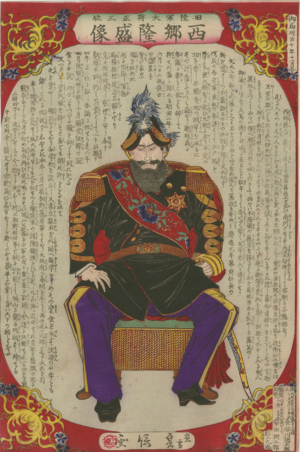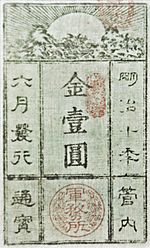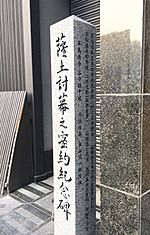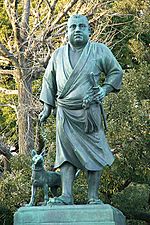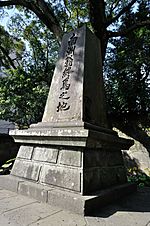Saigō Takamori facts for kids
Quick facts for kids
Saigō Takamori
|
|||||
|---|---|---|---|---|---|

A portrait of Takamori by Ishikawa Shizumasa
|
|||||
| Native name |
西郷 隆盛
|
||||
| Birth name | Saigō Kokichi | ||||
| Other name(s) | Saigō Nanshū Saigō Kichinosuke Kikuchi Gengo |
||||
| Born | January 23, 1828 Kagoshima, Satsuma Domain |
||||
| Died | September 24, 1877 (aged 49) Kagoshima, Empire of Japan |
||||
| Buried |
Nanshu Cemetery, Kagoshima Prefecture, Japan
|
||||
| Allegiance | Satsuma Domain | ||||
| Battles/wars |
|
||||
| Spouse(s) |
Suga Ijuin
(m. 1852; div. 1854)Otoma Kane "Aigana"
(m. 1859–1862)Iwayama Itoko
(m. 1865) |
||||
| Children | Saigō Kikujirō (son) Saigō Kikusō (daughter) Saigō Toratarō (son) Saigō Umajirō (son) Saigō Torizō (son) |
||||
| Relations |
|
||||
| Japanese name | |||||
| Hiragana | さいごう たかもり | ||||
| Katakana | サイゴウ タカモリ | ||||
| Kyūjitai | 西鄕 隆盛 | ||||
| Shinjitai | 西郷 隆盛 | ||||
|
|||||
Saigō Takamori (Takanaga) (西鄕 隆盛 (隆永), January 23, 1828 – September 24, 1877) was a Japanese samurai and nobleman. He was one of the most influential samurai in Japanese history and one of the three great nobles who led the Meiji Restoration. Living during the late Edo and early Meiji periods, he later led the Satsuma Rebellion against the Meiji government. Historian Ivan Morris described him as "the quintessential hero of modern Japanese history".
Contents
Early life
Saigō Kokichi (西郷 小吉) was born in Kajiya, Kagoshima, Satsuma Domain, the eldest son of samurai squire (koshōkumi) Saigō Kichibē and his wife Masa. He had six siblings and his younger brother was Marshal-Admiral Marquis Saigō Jūdō. His childhood name was Kokichi and he received the given name Takamori in adulthood. He wrote poetry under the name Saigō Nanshū (西郷 南洲).
Shogun Tokugawa Yoshinobu resigned, returning power to the Emperor in what came to be known as the Meiji Restoration. However, Saigō was one of the most vocal and vehement opponents to the negotiated solution, demanding that the Tokugawa be stripped of their lands and special status. His intransigence was one of the major causes of the subsequent Boshin War.
During the Boshin War, Saigō led the imperial forces at the Battle of Toba–Fushimi, and after led the imperial army toward Edo, where he accepted the surrender of Edo Castle from Katsu Kaishū.
Meiji bureaucrat
Although Ōkubo Toshimichi and others were more active and influential in establishing the new Meiji government, Saigō retained a key role, and his cooperation was essential in the abolition of the han system and the establishment of a conscript army. In 1871 he was left in charge of the caretaker government during the absence of the Iwakura Mission (1871–73).
Saigō initially disagreed with the modernization of Japan and the opening of commerce with the West. He famously opposed the construction of a railway network, insisting that money should rather be spent on military modernization.
Saigō did insist, however, that Japan should go to war with Korea in the Seikanron debate of 1873 due to Korea's refusal to recognize the legitimacy of the Emperor Meiji as head of state of the Empire of Japan, and insulting treatment meted out to Japanese envoys attempting to establish trade and diplomatic relations. At one point, he offered to visit Korea in person and to provoke a casus belli by behaving in such an insulting manner that the Koreans would be forced to kill him. However, the other Japanese leaders strongly opposed these plans, partly from budgetary considerations, and partly from realization of the weakness of Japan compared with the western countries from what they had witnessed during the Iwakura Mission. Saigō resigned from all of his government positions in protest and returned to his hometown of Kagoshima.
Satsuma Rebellion (1877)
Shortly thereafter, a private military academy known as the Shi-gakkō was established in Kagoshima for the faithful samurai who had also resigned their posts to follow him from Tokyo. These disaffected samurai came to dominate the Kagoshima government, and fearing a rebellion, the government sent warships to Kagoshima to remove weapons from the Kagoshima arsenal. This provoked open conflict, although with the elimination of samurai rice stipends in 1877, tensions were already extremely high. Although greatly dismayed by the revolt, Saigō was reluctantly persuaded to lead the rebels against the central government.
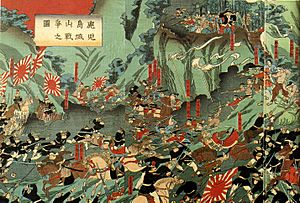
The rebels fought two significant battles against the central government: the Siege of Kumamoto Castle and the Battle of Tabaruzaka. Saigō was initially confident of his ability to take Kumamoto Castle, but he had underestimated the effectiveness of the imperial conscripts defending the castle. After a failed assault, Saigō settled for a siege. Imperial reinforcements eventually forced their way through the rebel lines at the Battle of Tabaruzaka, lifting the siege. The remnants of Saigō's army retreated before the advancing imperials, who whittled it down relentlessly. Eventually Saigō and his final remaining samurai were encircled and annihilated at the Battle of Shiroyama.
Saigō's death brought the Satsuma Rebellion to an end.
Death
During the battle of Shiroyama, Saigō was badly injured in the hip. However, the exact manner of his death is unknown. There are no published reports by eyewitnesses.
Legends
Multiple legends sprang up concerning Saigō, many of which denied his death. It was believed by some that he had fled to Russia, or ascended to Mars. It was even recorded that his image appeared in a comet near the close of the 19th century, an ill omen to his enemies. Unable to overcome the affection that the people had for this paragon of traditional samurai virtues, the Meiji-era government pardoned him posthumously on February 22, 1889. The Japanese people appreciated the fact that he remained loyal to his virtues until his death in 1877.
Artworks depicting Saigō
A famous bronze statue of Saigō in hunting attire with his dog stands in Ueno Park, Tokyo. Made by Takamura Kōun, it was unveiled on December 18, 1898. Saigō met the noted British diplomat Ernest Satow in the 1860s, as recorded in the latter's A Diplomat in Japan, and Satow was present at the unveiling as recorded in his diary.
A reproduction of the same statue stands on Okinoerabujima, where Saigō had been exiled.
A Japanese hand fan commemorating the event, which survives in the collection of the Staten Island Historical Society in New York, features a depiction of Saigō Takamori in a scene labeled (in English) "The Battle Near the Citadel of Kumamoto".
Family
Ancestry
| Ancestors of Saigō Takamori | |||||||||||||||||||||||||||||||||||||||||||||||||||||||||||||||||||||||||||||||||||||||||||||||||||||||||||||||||||||||||||||||||||||||||||||||||||||||||||||||||||||||||||||||||||||||||||||||||||||||||||||||||||||||||||||||||||||||||||||||||||||||||||||||||||||||||||||||||||||||||||||||||||||||||||||||||||||||||||||||||||||||||||||||||||||||||||||||||||||||||||||||||||||||||||||||||||||||||||||||||||||||||||||||||||||||||||||||||||||||||||||||||||||||||||||||||||
|---|---|---|---|---|---|---|---|---|---|---|---|---|---|---|---|---|---|---|---|---|---|---|---|---|---|---|---|---|---|---|---|---|---|---|---|---|---|---|---|---|---|---|---|---|---|---|---|---|---|---|---|---|---|---|---|---|---|---|---|---|---|---|---|---|---|---|---|---|---|---|---|---|---|---|---|---|---|---|---|---|---|---|---|---|---|---|---|---|---|---|---|---|---|---|---|---|---|---|---|---|---|---|---|---|---|---|---|---|---|---|---|---|---|---|---|---|---|---|---|---|---|---|---|---|---|---|---|---|---|---|---|---|---|---|---|---|---|---|---|---|---|---|---|---|---|---|---|---|---|---|---|---|---|---|---|---|---|---|---|---|---|---|---|---|---|---|---|---|---|---|---|---|---|---|---|---|---|---|---|---|---|---|---|---|---|---|---|---|---|---|---|---|---|---|---|---|---|---|---|---|---|---|---|---|---|---|---|---|---|---|---|---|---|---|---|---|---|---|---|---|---|---|---|---|---|---|---|---|---|---|---|---|---|---|---|---|---|---|---|---|---|---|---|---|---|---|---|---|---|---|---|---|---|---|---|---|---|---|---|---|---|---|---|---|---|---|---|---|---|---|---|---|---|---|---|---|---|---|---|---|---|---|---|---|---|---|---|---|---|---|---|---|---|---|---|---|---|---|---|---|---|---|---|---|---|---|---|---|---|---|---|---|---|---|---|---|---|---|---|---|---|---|---|---|---|---|---|---|---|---|---|---|---|---|---|---|---|---|---|---|---|---|---|---|---|---|---|---|---|---|---|---|---|---|---|---|---|---|---|---|---|---|---|---|---|---|---|---|---|---|---|---|---|---|---|---|---|---|---|---|---|---|---|---|---|---|---|---|---|---|---|---|---|---|---|---|---|---|---|---|---|---|---|---|---|---|---|---|---|---|---|---|---|---|---|---|---|---|---|---|---|---|---|---|---|---|---|---|---|---|---|---|---|---|---|---|---|---|---|---|---|---|---|---|---|---|---|---|---|---|---|---|---|---|---|---|---|---|---|---|---|---|---|---|---|---|---|
|
|||||||||||||||||||||||||||||||||||||||||||||||||||||||||||||||||||||||||||||||||||||||||||||||||||||||||||||||||||||||||||||||||||||||||||||||||||||||||||||||||||||||||||||||||||||||||||||||||||||||||||||||||||||||||||||||||||||||||||||||||||||||||||||||||||||||||||||||||||||||||||||||||||||||||||||||||||||||||||||||||||||||||||||||||||||||||||||||||||||||||||||||||||||||||||||||||||||||||||||||||||||||||||||||||||||||||||||||||||||||||||||||||||||||||||||||||||
Wives and children
- Ijūin Suga
- Aikana
- Saigō Kikujirō (son): Mayor of Kyoto City, studied politics at Johns Hopkins University
- Saigō Kikusō (daughter)
- Saigō Itoko
- Marquess Saigō Toratarō (son): Colonel in the army, studied at Prussian Military Academy
- Saigō Umajirō (son)
- Saigō Torizō (son)
Siblings
- Marshal-Admiral Marquess Saigō Jūdō (younger brother): Navy Minister
- Saigō Kichijirō (younger brother): Killed in action in the Boshin War
- Saigō Kohei (younger brother): Killed in action in the Satsuma Rebellion
- Ichiki Koto (younger sister)
- Saigō Taka (younger sister)
- Saigō Yasu (younger sister)
See also
 In Spanish: Saigō Takamori para niños
In Spanish: Saigō Takamori para niños
- Seikanron


